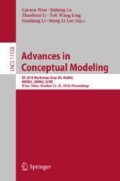Abstract
Digital Ecosystems consist of a variety of interlinked subsystems. This paper presents a flexible approach to define the links between such subsystems. The idea is to exploit the paradigm of Model Centered Architecture (MCA) and to specify all links/interfaces by means of appropriate Domain Specific Modeling Languages. The approach has been successfully applied and evaluated in several projects. As a proof of concept, we present the model-based interfacing between assistive systems and human activity recognition systems, which showed good performance as needed in real-world applications.
Access this chapter
Tax calculation will be finalised at checkout
Purchases are for personal use only
Notes
- 1.
Meta-Object FacilityTM http://www.omg.org/mof/.
- 2.
References
Bencomo, N., Bennaceur, A., Grace, P., Blair, G., Issarny, V.: The role of models@ run. time in supporting on-the-fly interoperability. Computing 95, 167–190 (2013)
Bencomo, N., France, R., Cheng, B.H.C., Aßmann, U. (eds.): Models@run.time: Foundations, Applications, and Roadmaps. LNCS, vol. 8378. Springer, Cham (2014). https://doi.org/10.1007/978-3-319-08915-7
Bennaceur, A., Issarny, V.: Automated synthesis of mediators to support component interoperability. IEEE Trans. Softw. Eng. 41, 221–240 (2015)
Chen, L., Khalil, I.: Activity recognition: approaches, practices and trends. In: Chen, L., Nugent, C., Biswas, J., Hoey, J. (eds.) Activity Recognition in Pervasive Intelligent Environments, pp. 1–31. Springer, Paris (2011). https://doi.org/10.2991/978-94-91216-05-3_1
Costa, F.M., Morris, K.A., Kon, F., Clarke, P.J.: Model-driven domain-specific middleware. In: Proceedings of ICDCS 2017, pp. 1961–1971. IEEE (2017)
Embley, D.W., Liddle, S.W., Pastor, O.: Conceptual-model programming: a manifesto. In: Embley, D., Thalheim, B. (eds.) Handbook of Conceptual Modeling, pp. 3–16. Springer, Heidelberg (2011)
Fill, H.-G., Karagiannis, D.: On the conceptualisation of modelling methods using the ADOxx meta modelling platform. EMISA J. 8, 4–25 (2013)
Götz, S., et al.: Adaptive exchange of distributed partial models@run.time for highly dynamic systems. In: Proceedings of SEAMS 2015, pp. 64–70. IEEE Press (2015)
Karpathy, A., Fei-Fei, L.: Deep visual-semantic alignments for generating image descriptions. In: Proceedings of IEEE Conference on Computer Vision and Pattern Recognition, pp. 3128–3137 (2015)
Kofod-Petersen, A., Cassens, J.: Using activity theory to model context awareness. In: Roth-Berghofer, T.R., Schulz, S., Leake, D.B. (eds.) MRC 2005. LNCS (LNAI), vol. 3946, pp. 1–17. Springer, Heidelberg (2006). https://doi.org/10.1007/11740674_1
Liddle, S.W.: Model-driven software development. In: Embley, D.W., Thalheim, B. (eds.) Handbook of Conceptual Modeling, pp. 17–54. Springer, Heidelberg (2011)
Mayr, H.C., et al.: HCM-L: domain-specific modeling for active and assisted living. In: Karagiannis, D., Mayr, H., Mylopoulos, J. (eds.) Domain-Specific Conceptual Modeling, pp. 527–552. Springer, Cham (2016)
Mayr, H.C., et al.: Model centered architecture. In: Cabot, J., Gómez, C., Pastor, O., Sancho, M., Teniente, E. (eds.) Conceptual Modeling Perspectives, pp. 85–104. Springer, Cham (2017). https://doi.org/10.1007/978-3-319-67271-7_7
Meditskos, G., et al.: MetaQ. Perv. Mob. Comput. 25, 104–124 (2016)
Michael, J., Steinberger, C.: Context Modeling for Active Assistance. In: Proceedings of ER Forum 2017. CEUR Workshop Proceedings 1979, CEUR-WS.org, pp. 207–220 (2017)
Michael, J., et al.: The HBMS Story. Enterp. Model. Inf. Syst. Arch. 13, 345–370 (2018)
Ni, Q., et al.: A foundational ontology-based model for human activity representation in smart homes. J. Ambient. Intell. Smart Environ. 8, 47–61 (2016)
Onofri, L., et al.: A survey on using domain and contextual knowledge for human activity recognition in video streams. Expert Syst. Appl. 63, 97–111 (2016)
Peláez, M.D., López-Medina, M., Espinilla, M., Medina-Quero, J.: Key factors for innovative developments on health sensor-based system. In: Rojas, I., Ortuño, F. (eds.) IWBBIO 2017,Part II. LNCS, vol. 10209, pp. 665–675. Springer, Cham (2017). https://doi.org/10.1007/978-3-319-56154-7_59
Ranasinghe, S., et al.: A review on applications of activity recognition systems with regard to performance and evaluation. Int. J. Distrib. Sens. Netw. 12, 1550147716665520 (2016)
Rodríguez, N.D., Cuéllar, M.P., Lilius, J., Calvo-Flores, M.D.: A survey on ontologies for human behavior recognition (CSUR). ACM Comput. Surv. 46, 43 (2014)
Siegel, C., Dorner, T.E.: Information technologies for active and assisted living—Influences to the quality of life of an ageing society. Int. J. of Med. Inform. 100, 32–45 (2017)
Zgheib, R., et al.: A flexible architecture for cognitive sensing of activities in ambient assisted living. In: Proceedings of WETICE 2017, pp. 284–289. IEEE (2017)
Author information
Authors and Affiliations
Corresponding author
Editor information
Editors and Affiliations
Rights and permissions
Copyright information
© 2018 Springer Nature Switzerland AG
About this paper
Cite this paper
Shekhovtsov, V.A., Ranasinghe, S., Mayr, H.C., Michael, J. (2018). Domain Specific Models as System Links. In: Woo, C., Lu, J., Li, Z., Ling, T., Li, G., Lee, M. (eds) Advances in Conceptual Modeling. ER 2018. Lecture Notes in Computer Science(), vol 11158. Springer, Cham. https://doi.org/10.1007/978-3-030-01391-2_37
Download citation
DOI: https://doi.org/10.1007/978-3-030-01391-2_37
Published:
Publisher Name: Springer, Cham
Print ISBN: 978-3-030-01390-5
Online ISBN: 978-3-030-01391-2
eBook Packages: Computer ScienceComputer Science (R0)

